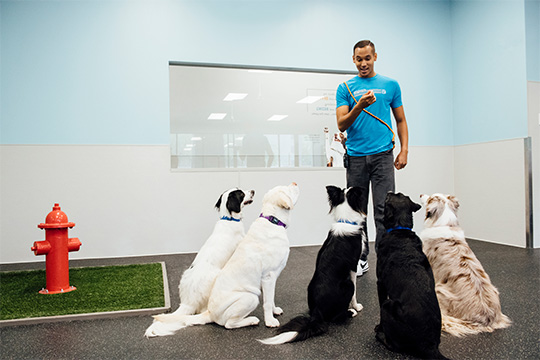Training your dog is not just about teaching tricks; it’s a science that involves understanding how dogs learn and respond to various techniques. To become an effective dog trainer, you must master the art of canine learning. In this guide, we’ll explore the science behind dog training and highlight some of the most effective methods to help you train your four-legged friend successfully.
The Science Behind Effective Dog Training
Effective dog training is rooted in the principles of behavioral science and understanding how dogs learn. Here are the key components:
1. Positive Reinforcement:
Positive reinforcement involves rewarding your dog with treats, praise, or toys when they exhibit desired behaviors. This method leverages the principle that dogs will repeat behaviors that result in rewards.
2. Clicker Training:
Clicker training utilizes a clicker device to mark the precise moment your dog performs the desired behavior, followed by a reward. It creates a clear and immediate association between the behavior and the reward.
3. Operant Conditioning:
This psychological theory explains how behaviors are influenced by their consequences. Positive reinforcement, negative reinforcement, positive punishment, and negative punishment are all part of operant conditioning, with positive reinforcement being the most effective in dog training.
4. Classical Conditioning:
Classical conditioning involves pairing a neutral stimulus with a rewarding or aversive stimulus to create an association. For example, using treats and a clicker to condition your dog to perform specific behaviors.
5. Cognitive Learning:
Dogs can also learn through cognitive processes, such as problem-solving and understanding cause-and-effect relationships. These mental exercises can stimulate your dog’s intelligence.
Effective Dog Training Methods
Now, let’s explore some of the most effective dog training methods rooted in the science of canine learning:
1. Positive Reinforcement Training:
Positive reinforcement involves rewarding your dog with treats, praise, or toys when they exhibit desired behaviors. This method capitalizes on the principle that dogs will repeat behaviors that result in rewards.
2. Clicker Training:
Clicker training employs a clicker device to mark the precise moment your dog performs the desired behavior, followed by a reward. It offers clear and immediate feedback, making it highly effective.
3. Operant Conditioning:
Understanding the principles of operant conditioning can help you employ positive reinforcement effectively while avoiding punitive methods.
4. Cognitive Training:
Engage your dog’s cognitive abilities with puzzle toys, interactive games, and training exercises that stimulate their problem-solving skills.
5. Behavior Modification:
For addressing specific behavioral issues, consult with a professional dog trainer or behaviorist who can employ science-based methods to modify your dog’s behavior.
Choosing the Right Dog Training Method
Selecting the right dog training method depends on various factors:
- Your Dog’s Personality: Consider your dog’s temperament, energy level, and individual preferences.
- Your Training Goals: Determine what specific behaviors you want to teach or correct in your dog.
- Your Training Resources: Assess the time, tools, and expertise you have available for training.
- Professional Guidance: If needed, consult with a professional dog trainer or behaviorist who can tailor a training plan based on your dog’s unique needs.
Common Training Pitfalls to Avoid
As you embark on your dog training journey, be mindful of these common pitfalls:
1. Punishment-Based Training:
Avoid using harsh punishments or physical corrections, as they can harm your dog’s trust and well-being.
2. Inconsistency:
Inconsistent training methods and rules can confuse your dog and impede their progress.
3. Neglecting Socialization:
Failure to provide early socialization experiences can lead to fear and aggression issues in the future.
4. Impatience:
Training takes time, and impatience can lead to frustration. Be persistent and understanding with your dog’s learning pace.
5. Overusing Treats:
While treats are excellent for positive reinforcement, overindulgence can lead to weight issues. Use them strategically.
Conclusion
Mastering the science of canine learning is a journey that allows you to understand how your dog thinks, learns, and responds to various training methods. By applying science-based techniques rooted in positive reinforcement and avoiding common training pitfalls, you can train your dog effectively while nurturing a strong and positive bond. Remember that a well-informed trainer can make the training process enjoyable for both you and your four-legged friend, resulting in a well-behaved and happy canine companion.







